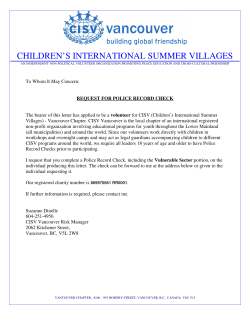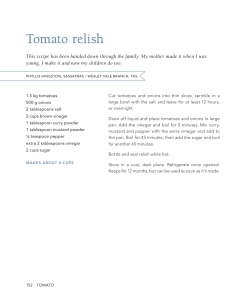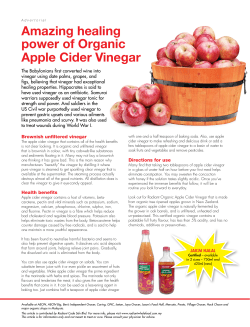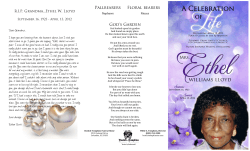
Mysterious Mixtures Science for 3—5 year-olds CAREGIVERS, PARENTS AND PRESCHOOL EDUCATORS
Mysterious Mixtures Science for 3—5 year-olds CAREGIVERS, PARENTS AND PRESCHOOL EDUCATORS provide many creative opportunities for young children to explore their world. That’s why we’ve created Big Science for Little Hands, an evolving suite of science resources for teachers and caregivers of 3–5-year-old children. Our aim is to develop activities that inspire further exploration and discovery. We hope that these resource materials complement what you are already doing and offer additional ideas to inspire further exploration. The activities have been designed for experiential learning. The intent is for children to experience each concept, rather than simply talking about it. Each activity can serve as a starting point for further exploration. The activities are divided into the following categories. Introductions—These could be used to set the stage for the topic, or to find out how much the children already know. They’re low-preparation, low-mess activities for a large group to do together. Explorations—These require a bit more set-up and clean-up. They work best with small groups of children. They’re intended to be open-ended, with a teacher or other adult available to pose questions and expand the activity as required. Make This—These explorations result in a product that children can take home or display. All Together—This big whole-group activity would make a great wrap-up to the topic. Connections—Ideas for extending the topic in cross-curricular ways. You know your group best! There is no perfect way to order or arrange these activities. They could be combined into a whole day on a theme, or taken one at a time over several weeks. Please pick and choose, expand or contract as makes sense for your group of children. We gratefully acknowledge the financial support of the Province of British Columbia through the Ministry of Education. Topics Now Available: Round the Circle Activities to explore round things and things that roll. Wet & Dry Activities to explore being wet and dry. Sticky Stuff Activities to explore stuff that sticks. Size Matters Activities to explore things that get bigger and things that get smaller. Mysterious Mixtures Activities to explore dissolving, separating, mixing and combining. September 2009 Science World British Columbia TELUS World of Science 1455 Quebec Street, Vancouver, BC Canada V6A 3Z7 t 604 · 443 ·7440 f 604 · 443 ·7430 w telusworldofscience.com/vancouver Check for more resource packages coming soon: scienceworld.ca/ preschool.html 1 Mysterious Mixtures We gratefully acknowledge the financial support of the Province of British Columbia through the Ministry of Education. A Path Through Mysterious Mixtures Here’s one possible way to put the activities in this resource together. Do one or two Introductions at circle time in a large group. Have the children try the Explorations and Make This in smaller groups at stations around the room. • Try All Together just before the end of the school day, or at the end of a few days on the topic. • • Introduction: Does it Dissolve? Exploration: Vinegar and Baking Soda Eruptions Introduction: Lava Bottles Exploration: Ooey Gooey Oobleck Make This: Coffee Filter Chromatography Make This: Sweet Treat: Homemade Ice Cream All Together: Pop Fountain Big Science for Little Hands supports the learning goals outlined in the British Columbia Early Learning Framework, particularly those in the area of Exploration and Creativity. To promote exploration and creativity, adults provide an environment where young children can do the following: • explore the world using their bodies and all their senses • build, create and design using different materials and techniques Share with us! Please send us your feedback, suggestions and ideas. Email bslh@scienceworld.ca Or visit scienceworld.ca/preschool. html and fill in an online survey. • actively explore, think and reason • identify and try possible solutions to problems in meaningful contexts and situations • be creative and expressive in various ways • develop a sense of wonder for natural environments • express a zest for living and learning (BC Early Learning Framework: bced.gov.bc.ca/early_learning/) Science World British Columbia TELUS World of Science 1455 Quebec Street, Vancouver, BC Canada V6A 3Z7 t 604 · 443 ·7440 f 604 · 443 ·7430 w telusworldofscience.com/vancouver Thank you to the children and families around British Columbia who assisted with the testing of the activities in this package. Thank you to The Canadian Children’s Book Centre who recommended many wonderful children’s stories. 2 Mysterious Mixtures: Introductions We gratefully acknowledge the financial support of the Province of British Columbia through the Ministry of Education. Does it Dissolve? What happens when we combine a liquid and a solid? When a solid dissolves, it seems to disappear, but it is still there, we just cannot see it. Sugar breaks down into tiny pieces and dissolves in water. When the sugar is completely distributed throughout the water, we call this a solution. However, not everything dissolves. Rocks and sand do not dissolve in water—they sink to the bottom. We call this a mixture. What you need • clear cups or other containers • water • sugar cubes • spoons • rock or gravel (similar size as sugar cube) Hands-on 1. Fill two clear cups or containers with warm water. 2. Make some predictions about what you think will happen when you add the sugar cube and the rock to the water. 3. Add one sugar cube to one cup and a rock to the other cup. 4. Observe. 5. Taste the sugar water to see if you can detect the sugar. Questions to ask What will happen to the sugar when we add it to the water? What will happen to the rock when we add it to the water? Where is the sugar now? Where is the rock now? Where did the sugar go? Can we get it back? What next? Where to next? INT RODUC T IONS Does it Dissolve Lava Bottles E XPLOR AT IONS Vinegar and Baking Soda Eruptions Ooey Gooey Oobleck MAKE THIS Coffee Filter Chromatography Sweet Treat: Homemade Ice Cream ALL TOGETHER Pop Fountain CONNECTIONS More Ideas Hint: Using warm water will make the sugar dissolve faster. Experiment with other substances in your kitchen (e.g. drink crystals, hard candies, pepper, sand, flour, salt). What dissolves (makes a solution) and what does not (makes a mixture)? Compare how quickly a sugar cube dissolves when you stir it and when you let it sit still. Compare how quickly a sugar cube dissolves in cold water and in warm water. Try pouring a small amount of sugar water onto a coloured dish. Allow the water to evaporate away (this might take a while). Can you find any sugar? Compare melting and dissolving. Melting is a change of state, dissolving is a solid being integrated into a liquid. Note for next time Science World British Columbia TELUS World of Science 1455 Quebec Street, Vancouver, BC Canada V6A 3Z7 t 604 · 443 ·7440 f 604 · 443 ·7430 w telusworldofscience.com/vancouver 3 Mysterious Mixtures: Introductions Lava Bottles We gratefully acknowledge the financial support of the Province of British Columbia through the Ministry of Education. Oil and water don’t mix. They stay separate because of their molecular structure. Scientists call them immiscible liquids. Oil is less dense (lighter for its size) then water, so it rises to the top. Salt is denser then both oil and water and sinks to the bottom. The salt drags some of the oil down as it sinks. The salt dissolves in the water and releases the oil, which rises back to the surface. What you need • clear plastic water bottle with lid • water • vegetable oil • food colouring • salt • spoon Hands-on 1. Pour water into the bottle until it is about one-third full. 2. Add about the same amount of vegetable oil to the bottle. Observe. 3. Add a few drops of food colouring. Observe. 4. Put the lid on tightly. 5. Shake the bottle vigorously. Observe. 6. Allow the bottle to sit undisturbed for a few minutes. Observe. 7. Add one spoonful of salt to the bottle. Observe. 8. Repeat step 7 as many times as you like. Questions to ask What happened when you: * Added the oil? Did it mix with the water? * Added the food colouring? Is the food colouring in the oil or the water? * Shook the bottle? * Let the bottle sit after shaking? Where to next? INT RODUC T IONS Does it Dissolve Lava Bottles E XPLOR AT IONS Vinegar and Baking Soda Eruptions Ooey Gooey Oobleck MAKE THIS Coffee Filter Chromatography Sweet Treat: Homemade Ice Cream ALL TOGETHER Pop Fountain CONNECTIONS More Ideas Hint: Observe the bottle from the side, not from the top. What did you notice when you added the salt? Where did the salt go? What did the oil do? What next? Add some dish soap to get the oil and water to mix. Soap is an emulsifier (a substance that can mix with both oil and water). Make oil and vinegar salad dressing. Add garlic or a little bit of mustard to help the oil and vinegar to mix. Dip vegetables in for a healthy snack. Science World British Columbia TELUS World of Science 1455 Quebec Street, Vancouver, BC Canada V6A 3Z7 t 604 · 443 ·7440 f 604 · 443 ·7430 w telusworldofscience.com/vancouver 4 Mysterious Mixtures: Explorations Vinegar and Baking Soda Eruptions We gratefully acknowledge the financial support of the Province of British Columbia through the Ministry of Education. Vinegar is an acid and baking soda is a base. When you combine them, they foam, bubble and overflow their container. The acid and base are reacting when they do this, neutralizing each other and creating salt, water and bubbles of carbon dioxide gas. What you need • tall narrow vase or similar container • vinegar • baking soda • food colouring • funnel • spoon • baking sheet, tray or pan Hands-on 1. Place the vase on the baking sheet. 2. Spoon some baking soda into the vase. 3. Add 2–3 drops of food colouring. 4. Pour in some vinegar. 5. Stand back and enjoy the reaction. 6. Repeat! Where to next? INT RODUC T IONS Does it Dissolve Lava Bottles E XPLOR AT IONS Vinegar and Baking Soda Eruptions Ooey Gooey Oobleck MAKE THIS Coffee Filter Chromatography Sweet Treat: Homemade Ice Cream ALL TOGETHER Pop Fountain CONNECTIONS More Ideas Questions to ask What do you think will happen when we mix the vinegar and baking soda? What did you see? Where did the bubbles come from? What next? Try combining different amounts of baking soda and vinegar. Hint: To make your vinegar usage more cost-effective, dilute it with water before you use it in this experiment. Add a bit of dish soap for extra bubbles. Make a volcano shape from aluminum foil and do the reaction in its crater. Explore other things that fizz, such as Alka-Seltzer tablets. Note for next time Science World British Columbia TELUS World of Science 1455 Quebec Street, Vancouver, BC Canada V6A 3Z7 t 604 · 443 ·7440 f 604 · 443 ·7430 w telusworldofscience.com/vancouver 5 Mysterious Mixtures: Explorations Ooey Gooey Oobleck We gratefully acknowledge the financial support of the Province of British Columbia through the Ministry of Education. Cornstarch and water make a fascinating mixture. For fun, we call it Oobleck. The cornstarch is suspended in the water (instead of dissolving like sugar). Stirring it or squeezing it with force causes it to behave rather like a solid. When it’s treated gently, it behaves more like a liquid. What’s happening? Applying a force to the Oobleck squeezes the water out from between the cornstarch bits. Pulling or pouring the Oobleck gently lets the water stay between the cornstarch bits. Scientists call Oobleck a non-Newtonian fluid. What you need • tray, cake pan or large bowl • cornstarch • water Hands-on 1. Combine equal parts water and cornstarch in the pan or bowl. 2. Get messy: stir, squeeze, pour, enjoy! Questions to ask How does the Oobleck feel? How long can you hold some in your hand? What happens when you squeeze it? What happens when you stir it quickly or slowly? What next? Try using spoons, sieves, spatulas and whisks in your Oobleck. Add more cornstarch or water to your mixture and observe how it changes. Note for next time Science World British Columbia TELUS World of Science 1455 Quebec Street, Vancouver, BC Canada V6A 3Z7 t 604 · 443 ·7440 f 604 · 443 ·7430 w telusworldofscience.com/vancouver Where to next? INT RODUC T IONS Does it Dissolve Lava Bottles E XPLOR AT IONS Vinegar and Baking Soda Eruptions Ooey Gooey Oobleck MAKE THIS Coffee Filter Chromatography Sweet Treat: Homemade Ice Cream ALL TOGETHER Pop Fountain CONNECTIONS More Ideas Hint: Get Messy! Do this activity outside on a warm day or somewhere where mess is okay. Dispose of Oobleck in the garbage, not down the sink. For easy cleanup, allow spilled Oobleck to dry and then sweep up with a broom. 6 Mysterious Mixtures: Make This Coffee Filter Chromatography The opposite of mixing is separating. The inks in felt pens (particularly brown and black ones) are often mixtures of several basic dye colours. We can separate the dyes in felt pens by colouring with the pens on coffee filters and dripping water on the designs. Scientists call this method of colour separation chromatography. What you need • water-based felt pens (Crayola, Mr. Sketch, etc.) • white basket-style coffee filters • water • droppers Hands-on 1. Smooth out the folds in a coffee filter. 2. Draw dots or lines on the filter with felt pens. 3. Drip a small amount of water onto the marks you made. 4. Watch to see what happens. 5. Add more dots or lines and water as desired. Questions to ask What colours do you think are hiding inside our black pen? What new colours do you see now that we have added the water? What next? Turn your coffee filters into art by cutting or shaping them into butterfly wings. Experiment with separating by other methods. Try separating a mixture of sand, gravel, beads, etc. using sieves and strainers or sorting coins using a sorter. We gratefully acknowledge the financial support of the Province of British Columbia through the Ministry of Education. Where to next? INT RODUC T IONS Does it Dissolve Lava Bottles E XPLOR AT IONS Vinegar and Baking Soda Eruptions Ooey Gooey Oobleck MAKE THIS Coffee Filter Chromatography Sweet Treat: Homemade Ice Cream ALL TOGETHER Pop Fountain CONNECTIONS More Ideas Hint: Felt pens labelled as “washable” or “wipeable” give less spectacular results than other water-based felts. Note for next time Science World British Columbia TELUS World of Science 1455 Quebec Street, Vancouver, BC Canada V6A 3Z7 t 604 · 443 ·7440 f 604 · 443 ·7430 w telusworldofscience.com/vancouver 7 Mysterious Mixtures: Make This Sweet Treat: Homemade Ice Cream We gratefully acknowledge the financial support of the Province of British Columbia through the Ministry of Education. Dissolve sugar in milk then cool it down to make a delicious treat. Fresh water freezes at zero degrees Celsius, but milk needs to be colder than that to freeze into ice cream. How can we make it colder? When we add salt to ice, it dissolves in the water on the surface of the ice cubes. Salty water freezes at a much lower temperature than fresh water. The salt and ice mixture gets much colder than zero degrees Celsius. The mixture also cools milk enough to make your yummy treat. What you need (per ½ cup serving): • 50 mL (1/4 cup) 2% milk • 50 mL (1/4 cup) whipping cream • 25 mL (5 tsp) sugar • 0.5 mL (1/8 tsp) vanilla or vanilla flavouring • 100-175 mL (1/2 cup) salt • 500 mL (2 cups) ice cubes • one 1 L (1 quart) zip-top bag • one 4 L (1 gallon) zip-top bag • spoon • measuring cups/spoons Hands on 1. Measure the sugar, milk, whipping cream and vanilla into the smaller zip-top bag. 2. Seal the bag securely. 3. Put the ice cubes into the larger zip-top bag. 4. Add salt to the bag of ice. 5. Place the sealed smaller bag inside the larger bag of ice and salt. 6. Seal the larger bag securely. 7. Gently rock the large bag from side to side. Caution, cold! 8. Shake and rock the bag for 5-10 minutes or until the contents of the smaller bag have solidified into ice cream. 9. Remove the small bag, open it, grab a spoon and enjoy! Where to next? INT RODUC T IONS Does it Dissolve Lava Bottles E XPLOR AT IONS Vinegar and Baking Soda Eruptions Ooey Gooey Oobleck MAKE THIS Coffee Filter Chromatography Sweet Treat: Homemade Ice Cream ALL TOGETHER Pop Fountain CONNECTIONS More Ideas Hint: It is best to hold the large bag by the top seal or to have gloves or a cloth between the bag and your hands. Questions to ask What happens to the sugar when we add it to the milk? What happens to the salt when we add it to the ice? What are we making? How does your bag feel? What does your mixture taste like? What next? Experiment with making different ice cream flavours by adding chocolate, fruit or other flavourings. Science World British Columbia TELUS World of Science 1455 Quebec Street, Vancouver, BC Canada V6A 3Z7 t 604 · 443 ·7440 f 604 · 443 ·7430 w telusworldofscience.com/vancouver 8 Mysterious Mixtures: All Together We gratefully acknowledge the financial support of the Province of British Columbia through the Ministry of Education. Pop Fountain Use the “explosive” property of carbonated drinks to create a fountain of pop! Gum arabic on the Mentos’ surface breaks up the surface tension of the water in the pop, allowing the carbon dioxide gas to release in a big rush. Lots of the pop goes along for the ride and shoots high in the air. Where to next? What you need • 2L bottle of carbonated pop (diet cola works best) • mint Mentos • pop bottle lid with a 5mm diameter hole drilled • string • masking tape 10 cm • scissors Hands-on 1. Stick three Mentos together with loops of tape. 2. Hang the chain of Mentos from about 10 cm of string. (diagram here) 3. Go outside with the pop, drilled lid, strung Mentos and scissors. 4. Thread the long end of the string through the hole in the drilled lid. 5, Place the bottle on level ground. Take the lid off the 2L bottle of pop and screw the prepared one onto the bottle (keep holding the string). The Mentos should be suspended inside the neck of the bottle. 6. Make sure everyone is far back. Snip the string to release the Mentos. Step back quickly and enjoy! Questions to ask What will happen when we put the Mentos in the pop? What made the pop shoot up in the air? How high did the pop go? What next? Experiment with adding different amounts of Mentos or using different flavours of pop. Note for next time Science World British Columbia TELUS World of Science 1455 Quebec Street, Vancouver, BC Canada V6A 3Z7 t 604 · 443 ·7440 f 604 · 443 ·7430 w telusworldofscience.com/vancouver INT RODUC T IONS Does it Dissolve Lava Bottles E XPLOR AT IONS Vinegar and Baking Soda Eruptions Ooey Gooey Oobleck MAKE THIS Coffee Filter Chromatography Sweet Treat: Homemade Ice Cream ALL TOGETHER Pop Fountain CONNECTIONS More Ideas Hint: The coke can spray anywhere from 2 to 9 metres high! Diet pop is less sticky to clean up then regular pop. Steve Spangler Science sells a “geyser tube” for dropping Mentos into pop: stevespanglerscience.com 9 Mysterious Mixtures: Connections More Ideas We gratefully acknowledge the financial support of the Province of British Columbia through the Ministry of Education. Mixture Songs, Rhymes and Circle Games • Pat-a-cake Where to next? • Purple Stew • Make Cookies • Betty Batter Mixture Snacks • Pancakes, cakes, muffins, cookies or other baked treats • Layered gelatin (e.g. Dr. Oetker Trio Treat) Children’s books about mixtures Hannah’s Collections by Marthe Jocelyn Purple, Green and Yellow by Robert Munsch Art’s Supplies by Chris Tougas Bartholomew and the Oobleck by Dr. Seuss Resources for teachers 123 I Can Paint! by Irene Luxbacher Science Play! Beginning Discoveries for 2-6 year-olds by Jill Frankel Hauser Kids Cooking: A Very Slightly Messy Manual by *Klutz Editors Sesame Street C is for Cooking: Recipes from the Street by Susan McQuillan Science World British Columbia TELUS World of Science 1455 Quebec Street, Vancouver, BC Canada V6A 3Z7 t 604 · 443 ·7440 f 604 · 443 ·7430 w telusworldofscience.com/vancouver INT RODUC T IONS Does it Dissolve Lava Bottles E XPLOR AT IONS Vinegar and Baking Soda Eruptions Ooey Gooey Oobleck MAKE THIS Coffee Filter Chromatography Sweet Treat: Homemade Ice Creamy ALL TOGETHER Pop Fountain CONNECTIONS More Ideas 10
© Copyright 2025









